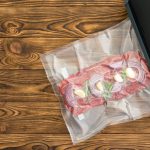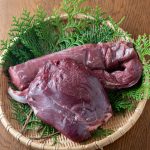Sous-vide cooking, a culinary technique that has gained popularity in recent years, involves cooking food in a precisely controlled water bath at a consistent low temperature for an extended period. The term “sous-vide” is French for “under vacuum,” which refers to the vacuum-sealed bags often used to hold the food during the cooking process. The method was introduced by French chef Georges Pralus. This method offers a unique approach to cooking that preserves the natural flavors, textures, and nutrients of the ingredients, resulting in tender, juicy, and evenly cooked dishes.
The technology, before we start discussing has been reviewed well (Kathuria et al., 2022).
The sous-vide process begins with the preparation of the food. Ingredients are typically seasoned and vacuum-sealed in plastic bags to remove air and create a tight seal. This step not only helps to lock in flavors but also ensures even cooking by allowing the water to make direct contact with the food. The technology of vacuum packing goes hand in hand with this type of cooking but it’s worth examining the method further.
Once the food is sealed, it is placed in a water bath that has been heated to the desired temperature using a sous-vide immersion circulator or a specialized water oven. These devices maintain the water temperature with precision, usually within a fraction of a degree, throughout the cooking process. This precise control is essential for achieving consistent results and preventing overcooking.
The cooking times for sous-vide dishes can vary significantly depending on the type of food and desired level of doneness. While some foods, such as tender cuts of meat, may only require a few hours of cooking, tougher cuts or vegetables might benefit from longer cooking times, sometimes up to 48 hours or more. Despite the extended cooking durations, sous-vide cooking does not typically require constant monitoring, making it convenient for home cooks and professional chefs alike.
One of the key benefits of sous-vide cooking is its ability to produce consistently perfect results. Because the temperature remains constant throughout the cooking process, there is little risk of overcooking or undercooking the food. This precision allows cooks to achieve specific levels of doneness, whether it’s a medium-rare steak, a perfectly poached egg, or tender vegetables with just the right amount of bite.
Additionally, sous-vide cooking offers unparalleled control over flavor infusion. By sealing ingredients in a vacuum bag, flavors are intensified as they are trapped and absorbed during the cooking process. This makes it easy to infuse meats with marinades, herbs, spices, and aromatics, resulting in dishes that are rich in flavor and complexity.
Another advantage of sous-vide cooking is its ability to tenderize tough cuts of meat. The gentle, low-temperature cooking breaks down connective tissues without causing the proteins to become tough or dry. As a result, even inexpensive cuts of meat can be transformed into tender, succulent dishes with sous-vide cooking.
Furthermore, sous-vide cooking is incredibly versatile and can be used to prepare a wide range of foods, including meats, poultry, fish, seafood, vegetables, fruits, eggs, and even desserts. From perfectly cooked steaks and juicy chicken breasts to vibrant vegetables and delicate custards, the possibilities are virtually endless with sous-vide cooking.
The technology has been compared to other types of vacuum cooking such as vacuum boiling (VB) and vacuum steaming (VS).
For meat and sea foods, the temperature of cooking under vacuum is usually 70ºC while vegetables are cooked above 85ºC.
Meat
.
Fish
Fish is a suitable product for sous-vide cooking. The cooking of Largemouth Bass (Micropterus salmoides) and its quality has been compared using three vacuum methods i.e. vacuum boiling (VB), vacuum steaming (VS)) or sous-vide cooking (SV) and then compared with more conventional cooking technology such as boiling and steaming (but not under vacuum) (Wan et al., 2019). As in most cooking technologies, the quality of the food prepared by each method is compared by monitoring the pH, cooking loss, colour and texture. These are all excellent monitors of physicochemical changes.
Meat
Meats are often cooked using all sorts of methods from steaming to roasting. Unfortunately, they suffer from overcooking with loss of texture and taste because of uneven heat conduction. The heat load at the surface is almost twice as that at the core.
Poultry
Chinese cooking often relies on cooking using the traditional methods of boiling and steaming but the quality of poultry such as duck (Zhang et al., 2022) is vastly improved.
Vegetables
Analysis
The analytical methods to employ are the following when comparing cooking methods:
- lipid oxidation – thiobarbituric acid (TBA)
- food microstructure – scanning electron microscopy (SEM)
- structural changes in muscle – Raman spectroscopy
- water migration and its distribution – low-field nuclear magnetic resonance (LF-NMR).
In addition to its culinary advantages, sous-vide cooking also offers practical benefits. Because the food is sealed in a vacuum bag, there is minimal evaporation during the cooking process, which helps to retain moisture and nutrients. This makes sous-vide cooking a healthier option compared to traditional cooking methods that may require added fats or oils to prevent dryness.
Furthermore, sous-vide cooking can be a time-saving technique, especially for busy individuals. Once the food is sealed and placed in the water bath, there is little hands-on time required, allowing cooks to multitask or attend to other tasks while the food cooks. Additionally, because the food can be cooked in advance and safely held at the desired temperature, it is easy to plan and prepare meals ahead of time, making sous-vide cooking ideal for meal prep and entertaining.
Despite its many benefits, sous-vide cooking does have some limitations and considerations to keep in mind. One potential drawback is the initial investment required for equipment, including a sous-vide immersion circulator or water oven, as well as vacuum sealer bags or equipment. However, the cost of sous-vide equipment has become more affordable in recent years, making it increasingly accessible to home cooks.
Additionally, while sous-vide cooking produces perfectly cooked food with minimal effort, it may lack the Maillard reaction—a chemical reaction that creates the browned, flavorful crust on grilled or seared foods. To achieve this desirable crust, sous-vide-cooked foods are often finished with a quick sear in a hot pan or on a grill, a step known as “finishing.”
Furthermore, food safety is a critical consideration when using sous-vide cooking. Because the food is cooked at low temperatures for an extended period, there is a risk of bacterial growth if proper precautions are not taken. It is essential to follow food safety guidelines, including using fresh, high-quality ingredients, properly sealing the food in vacuum bags, and ensuring that the water bath is maintained at the appropriate temperature throughout the cooking process.
Sous-vide cooking is a revolutionary culinary technique that offers precise control, consistent results, and unparalleled flavor infusion. From tender meats and perfectly poached eggs to vibrant vegetables and decadent desserts, sous-vide cooking allows cooks to unleash their creativity in the kitchen while achieving restaurant-quality dishes at home. While it does require some initial investment in equipment and attention to food safety, the benefits of sous-vide cooking make it a valuable addition to any cook’s repertoire, whether they are a home cook or a professional chef.
References
Kathuria, D., Dhiman, A. K., & Attri, S. (2022). Sous vide, a culinary technique for improving quality of food products: A review. Trends in Food Science & Technology, 119, pp. 57-68 (Article)
Wan, J., Cao, A., & Cai, L. (2019). Effects of vacuum or sous-vide cooking methods on the quality of largemouth bass (Micropterus salmoides). International Journal of Gastronomy and Food Science, 18, 100181. (Article)
Zavadlav, S., Blažić, M., Van de Velde, F., Vignatti, C., Fenoglio, C., Piagentini, A. M., … & Putnik, P. (2020). Sous-vide as a technique for preparing healthy and high-quality vegetable and seafood products. Foods, 9(11), 1537 (Article).
Zhang, M., Chen, M., Fang, F., Fu, C., Xing, S., Qian, C., … & Jin, C. (2022). Effect of sous vide cooking treatment on the quality, structural properties and flavor profile of duck meat. International Journal of Gastronomy and Food Science, 29, 100565 (Article).



Leave a Reply